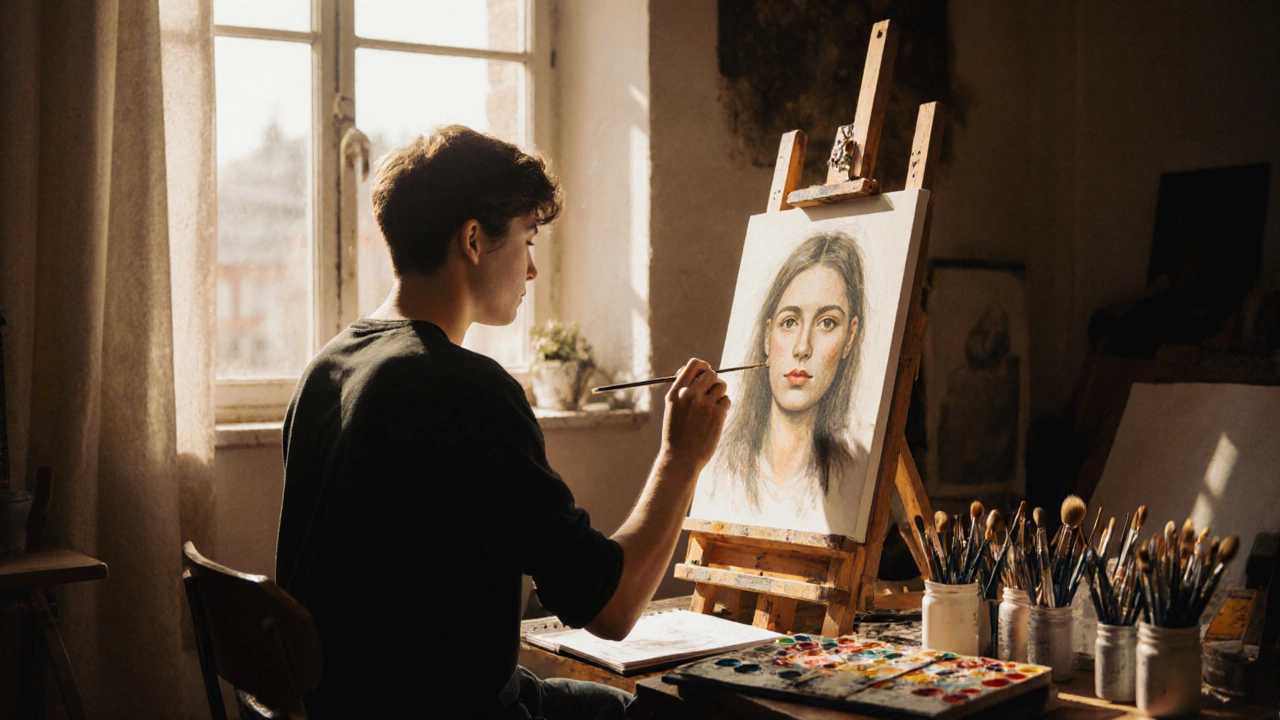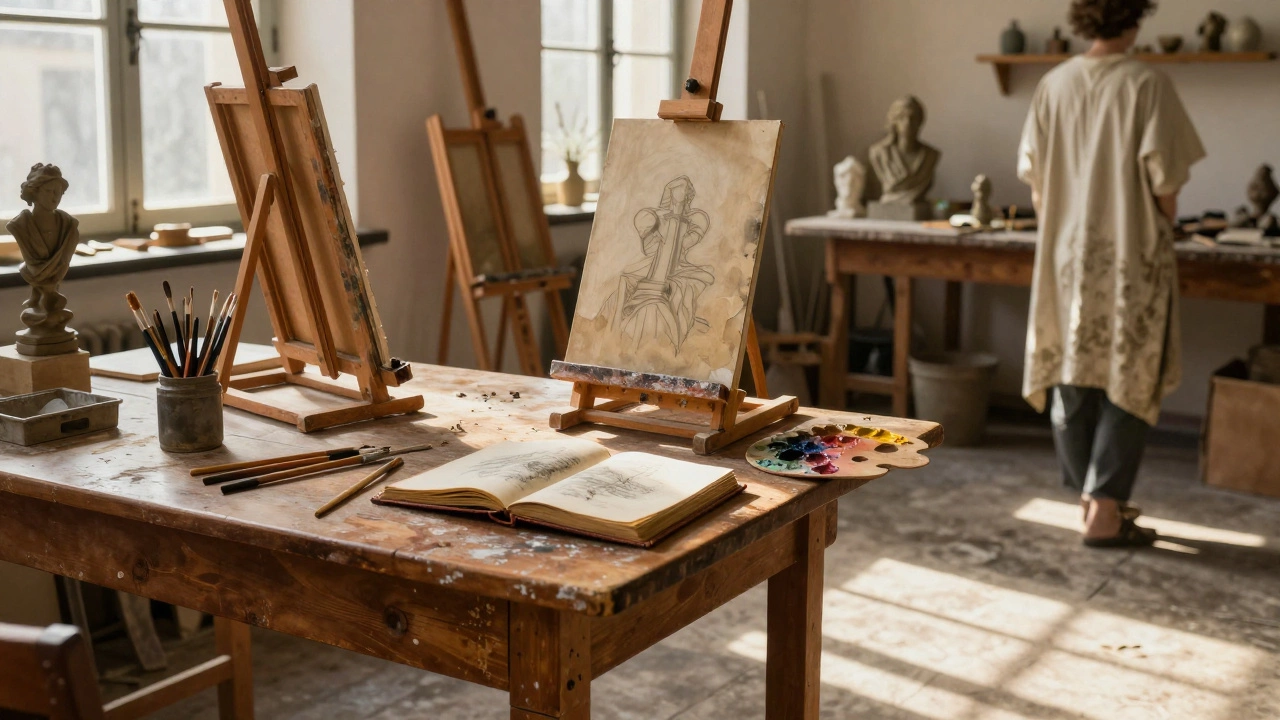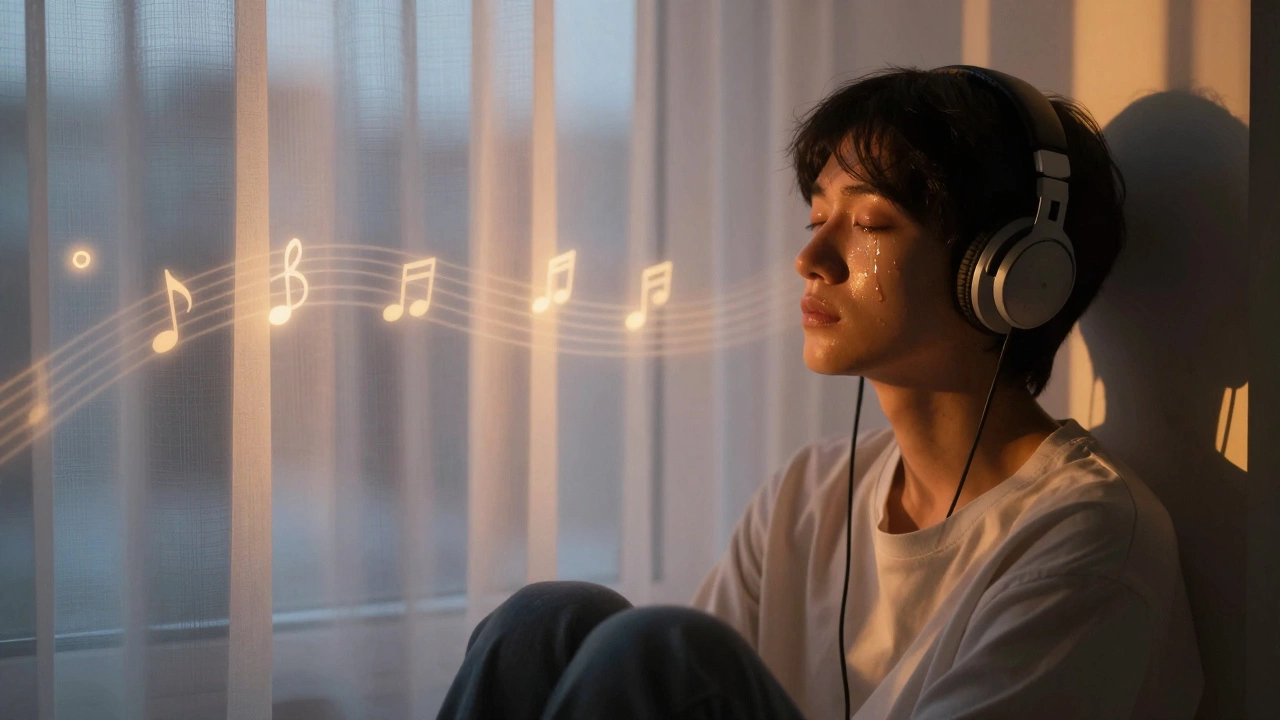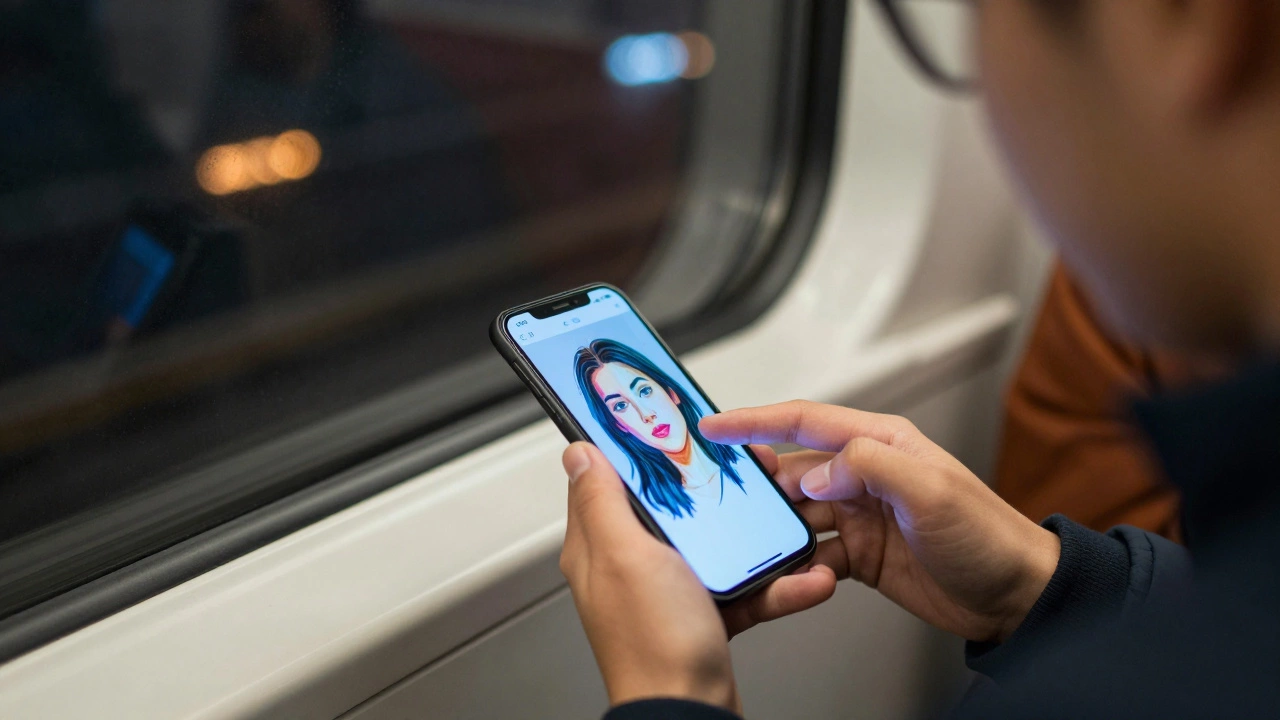Portrait Pricing Calculator
Portrait Pricing Calculator
Calculate professional portrait pricing based on industry standards from the article. Enter your time, hourly rate, and materials costs to determine your fair price.
How much do portraits sell for? It’s not a simple number. A portrait painted by a student in their dorm room might sell for $50. A commissioned portrait from a top-tier artist could cost $50,000 or more. The difference isn’t just skill-it’s context, reputation, medium, and who’s buying.
What Drives the Price of a Portrait?
Portraits aren’t like mass-produced posters. Each one carries the weight of time, emotion, and personal connection. The price reflects how much effort went into capturing someone’s essence. A 20-hour painting of your dog? That’s different from a 120-hour oil portrait of a CEO commissioned by a family trust.
Four main factors decide the price: artist reputation, medium, size, and where it’s sold.
Artist reputation matters more than you think. If you’re an unknown painter selling at a local craft fair, you might charge $200-$500 for a 16x20 inch portrait. But if you’re someone whose work has been shown at the Art Gallery of New South Wales or collected by a museum, your rates jump into the thousands-even tens of thousands. There’s no magic formula. It’s trust. Buyers pay for the name they recognize, the proof of past sales, the validation from institutions.
Medium changes everything. A pencil sketch on paper costs less than a watercolor, which costs less than an oil painting. Why? Oil takes weeks. It needs layers, drying time, varnish, and careful handling. A watercolor might be finished in a day. A charcoal sketch? Maybe two hours. The materials add up too: professional-grade oils, linen canvas, archival paper-these aren’t cheap.
Size follows logic. A 5x7 inch mini portrait? That’s $150-$400. A full-length 36x48 inch oil? That’s $3,000-$15,000. But don’t assume bigger always means more expensive. A tiny, hyper-detailed miniature portrait on ivory by a master can sell for $8,000. It’s not just square inches-it’s density of detail.
Where Portraits Actually Sell
Where you sell makes a huge difference in what you earn. Selling directly to a client cuts out the middleman. Most artists who do commissioned portraits earn 80-100% of the final price. That’s how many professionals make their living.
But if you sell through a gallery, they take 30-50%. That means if a portrait sells for $5,000, you might walk away with $2,500. Galleries offer exposure, credibility, and access to buyers who wouldn’t find you on Instagram. But they also demand exclusivity, high-quality presentation, and consistent output. You can’t just drop in a sketch and expect a sale.
Online marketplaces like Etsy, Saatchi Art, or Artfinder let you reach global buyers. But competition is brutal. Thousands of portrait artists list their work there. To stand out, you need strong photos, clear descriptions, and social proof-reviews, past sales, media features. On Etsy, most portrait artists charge $100-$600. Only a few hit $1,000+.
Private collectors and auction houses are another world. If you’re painting portraits for high-net-worth clients, you’re not competing with Etsy sellers. You’re working through referrals, word-of-mouth, or art consultants. A portrait of a philanthropist’s child, painted in oil on canvas, signed and dated, could easily sell for $10,000-$30,000 if the artist has a track record. In rare cases, portraits by established names like Lucian Freud or Alice Neel have sold for millions at Christie’s or Sotheby’s. But those are exceptions, not the norm.
Real Prices from Artists in 2025
Let’s get specific. Here’s what actual portrait artists in Australia, the U.S., and Europe are charging in late 2025:
- Student or hobbyist (local commissions): $100-$400 for a head-and-shoulders portrait in pencil, charcoal, or digital. Often done for friends, family, or small events.
- Emerging professional (1-3 years experience): $500-$1,500 for oil or acrylic portraits on 16x20 or 20x24 inch canvas. Usually sold directly via Instagram or personal website.
- Mid-career artist (5+ years, gallery representation): $2,000-$8,000. Often includes multiple sittings, detailed background elements, and custom framing. Sold through galleries or private commissions.
- Established artist (national recognition, museum exhibitions): $10,000-$50,000+. These artists often have waiting lists. Clients may pay deposits of $5,000 just to get on the schedule.
- Miniature portrait (historical style, fine detail): $1,500-$10,000. These are painted on ivory, vellum, or small metal panels. Often commissioned for family heirlooms.
- Photorealistic portrait (digital or traditional): $800-$6,000. High demand for corporate headshots, memorial portraits, or celebrity-style renderings.
One artist in Melbourne, Sarah Lin, told me she charges $4,200 for a full oil portrait. She spends 6-8 weeks on each piece. Her clients are mostly doctors, lawyers, and retired executives. She doesn’t advertise. Her last three portraits were sold through referrals from previous clients.
In contrast, a digital portrait artist in Los Angeles named Marcus Rojas sells 10-15 portraits a month on Etsy for $120 each. He uses Procreate and delivers in 3 days. He makes $15,000 a year-solid side income, but not a career.

Why Some Portraits Are Worth More Than Others
Not all portraits are created equal. A photo-realistic likeness of your cousin’s cat? That’s sentimental. A portrait of a historical figure painted by a renowned artist? That’s cultural value.
Portraits gain value when they’re tied to something bigger. A portrait of a famous person-like a politician, artist, or scientist-by a respected artist becomes collectible. Think of the portrait of Queen Elizabeth II by Lucian Freud. It wasn’t just a face. It was a moment in time, painted by one of the greatest artists of the 20th century. That’s why it sold for over $1 million.
Provenance matters. If a portrait was owned by a well-known collector, exhibited in a gallery, or mentioned in a book, its value increases. Documentation-signed certificates, exhibition labels, letters from the artist-adds legitimacy.
Condition counts too. A portrait with fading paint, water damage, or poor framing loses value. Restoration can help, but it can also reduce authenticity. Original frames from the artist’s time? That’s a bonus.
How to Price Your Own Portraits
If you’re an artist trying to set your prices, here’s a simple formula that works for most:
- Calculate your time: How many hours will you spend? Multiply that by your hourly rate. Most professional artists charge $40-$120/hour depending on experience.
- Add material costs: Canvas, paints, brushes, varnish, framing. Don’t guess-track it. A 24x36 inch oil painting might cost $150 in supplies.
- Add a profit margin: Multiply your total (time + materials) by 1.5 to 2. This covers overhead, marketing, and taxes.
Example: You spend 40 hours on a portrait. Your rate is $60/hour. Materials cost $180.
Time cost: 40 × $60 = $2,400
Materials: $180
Subtotal: $2,580
Multiply by 1.8 (profit margin): $4,644
Round to $4,600. That’s your asking price.
But here’s the catch: people don’t always pay based on hours. They pay based on perceived value. If your style is unique, if your portfolio looks professional, if you’ve built trust-your price can be higher. You’re not selling time. You’re selling recognition, emotion, legacy.
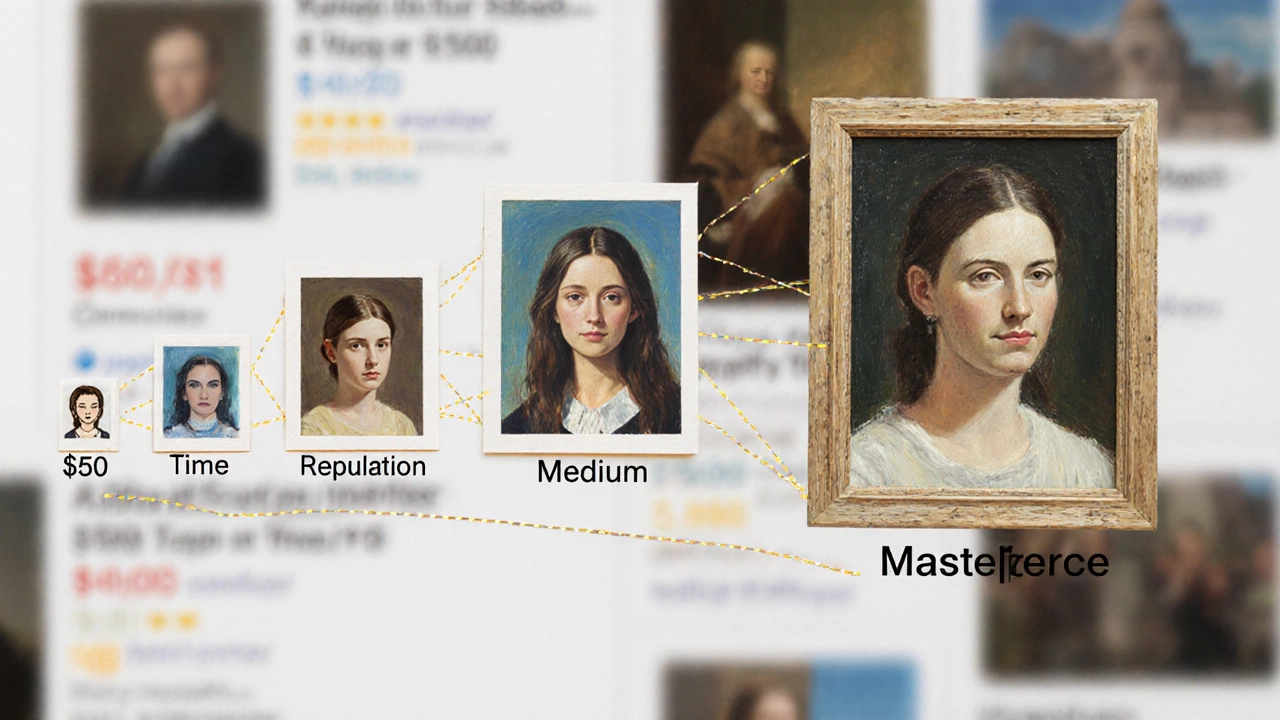
What Buyers Really Want
Most people commission portraits for one of three reasons: to honor someone, to own something unique, or to invest.
If it’s for a loved one-say, a portrait of a grandparent after they pass-price is secondary. They want it done right. They’ll pay more if they feel the artist understands the emotional weight.
If it’s for decoration, they want it to match their home. They care about style, color, and size. They’ll compare prices across Etsy, local artists, and online galleries.
If it’s for investment, they look for artists with growing reputations. They check past auction results, gallery shows, and collector lists. They don’t buy portraits they like-they buy portraits they think will appreciate.
One buyer in Sydney told me she paid $7,500 for a portrait of her daughter. She didn’t care about the technique. She cared that the artist captured her daughter’s laugh in her eyes. That’s what made it priceless to her.
Can You Make a Living Selling Portraits?
Yes-but not by accident. Top portrait artists don’t wait for clients to find them. They build systems.
They post consistent work on Instagram. They offer limited-time discounts for early bookings. They have a waiting list. They sell prints of their portraits to make extra income. Some even teach online courses on portrait painting.
One artist in Brisbane, Daniel Torres, makes $90,000 a year from portraits alone. He does 12 commissions a year at $7,500 each. He spends 60 hours per portrait. His secret? He doesn’t do sketches. He only takes one photo from the client, then paints from memory and emotion. That’s his brand. People pay for that uniqueness.
But if you’re just starting out, don’t expect to quit your day job right away. Most artists spend 2-3 years building a client base before they can rely on portrait sales alone.
Final Thoughts
There’s no single answer to how much portraits sell for. It ranges from $50 to $500,000. The price isn’t about the face on the canvas-it’s about the story behind it, the hand that painted it, and the person who wanted it enough to pay for it.
If you’re buying, know what you’re paying for. If you’re selling, don’t undervalue your work. Your time, your skill, your vision-they’re worth more than you think.
